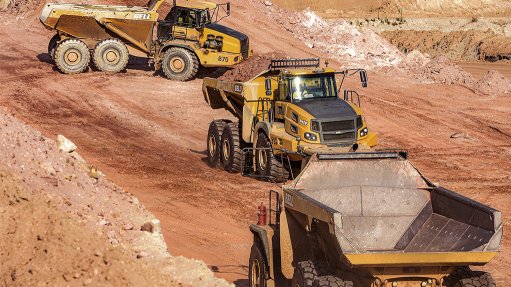
The Bell ADT
Bell Equipment will launch its first autonomous articulated dump truck (ADT) on the global market next year, says Bell Equipment CEO Leon Goosen.
The truck will also be available in South Africa.
The truck is the standard Bell ADT product which is then transformed into an autonomous product through add-ons from Bell and its regional partner companies.
Goosen tells Engineering News Online that the term ‘autonomous’ does not mean that the truck thinks for itself.
Customers, such as mining companies, will still have to programme the vehicle to perform its duties according to their operational demands.
“The truck wouldn’t know what to load where. Somebody would have to tell it what to do. You would have to programme the truck, and only then would it be able to perform the tasks without an operator.”
Bell’s autonomous ADT makes its debut in the US this month, at MINEXPO 2021 in Las Vegas.
In the US, Bell Equipment Engineering Research and Development and Pronto AI have been working for around 18 months to engineer and refine Pronto AI’s own developed hardware and software to produce and prove a self-drive Bell ADT.
Bell Trucks America provided a brand-new B50E as a test unit to Pronto AI in November last year.
This unit has been operating on several mine sites on the American west coast, allowing Pronto and Bell the time and experience to get the product to where it is today, which is self-driving on a mine site through full load and haul cycles over and over again.
Autonomy is achieved by marrying Pronto AI’s plug-and-play hardware and software with the autonomous-ready platform of the Bell ADT. The result is a fully autonomous standard Bell ADT, able to operate through the load, haul and dump cycle without an operator.
Bell is aiming for the truck to be the most affordable autonomous ADT in the world.
The JSE-listed Bell Equipment group also recently launched the Bell tracked carrier, with this product only available in the northern hemisphere, where it is able to operate in harsh conditions such as snow and mud.
These carriers are geared for the short haul and able to provide a niche solution to the pipelaying industry. They are, however, also used as people carriers on ski slopes or as flat-deck goods carriers, for example.
The tracked carrier has been extremely well received with almost all the units that have landed in the US sold, says Goosen.
The product is manufactured at the Bell plant in Richards Bay, KwaZulu-Natal.
“We are busy developing another two new products which should be on the market in the next two to three years,” notes Goosen.
“We aim to be global market leaders. We have the know-how and the ability in South Africa to compete with the world’s best.”
The Bell Equipment group last week announced its financial results for the six months ended June 30.
The group recorded profit after tax of R176-million, compared with a R52-million loss in the same period last year.
Revenue was up 25%, to R3.84-billion.
The group’s solid performance is largely owing to increased production volumes at the South African and German factories, as well as more sustainable sales volumes on the back of stronger global markets and a stabilised product range following major product upgrades, says Goosen.